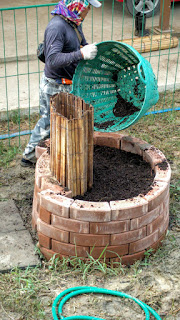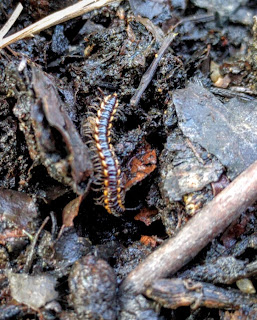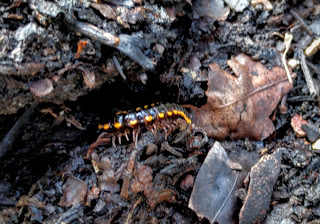Praew is always reading up on new kinds of (easy) ways to grow plants. Particularly food plants. One concept that caught her attention is called a “keyhole garden“.
So we went ahead and built our interpretation of one over the weekend. Ours is a little smaller and simpler than the typical variety, but should work the same way.
It is just a brick wall:
You can see a little bit of compost at the bottom and some cardboard sheet mulch.
Then we put in an old moldy outdoor bamboo curtain to make a roughly circular area in the center where you can throw kitchen scraps and other compostable materials:
There are hundreds of these guys that have made a home in this area of the yard. I’m uncertain if they are poisonous, but the rule of thumb is that if they have bright colors, they probably are… 🙁
This was the first link I found for a similar looking millipede whose “dark coloration with contrasting yellow-tipped keels warn of its ability to exude toxic hydrogen cyanide as a defense”. A bit troubling.
But I’m pretty sure this isn’t the one we have. Ours is more likely this one, signified by a “transverse groove in each segment” and is native to Southeast Asia. Compare this picture from the Wikipedia page to my picture above. Looks quite similar to an amateur eye.
The page for this guy doesn’t say that it has the hydrogen cyanide thing, but the previous page says “The ability to secrete hydrogen cyanide is shared by other members of the Polydesmida, the largest order of millipedes”, and this guy is a member of the order Polydesmida.
So now I have to look up how it “exudes toxic hydrogen cyanide”. Sounds almost like the alien from Aliens really.
The good news is that it might be more for smaller predators. The Wikipedia page on millipedes says this about these toxic excretions:
“Primates such as capuchin monkeys and lemurs have been observed intentionally irritating millipedes in order to rub the chemicals on themselves to repel mosquitoes.”
If monkeys use it as mosquito repellent, maybe it won’t kill me. 🙂




